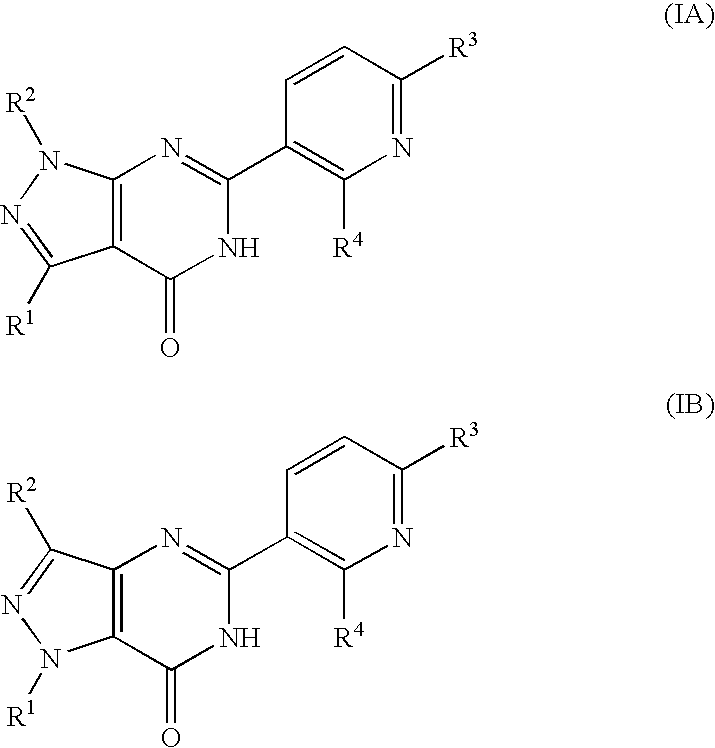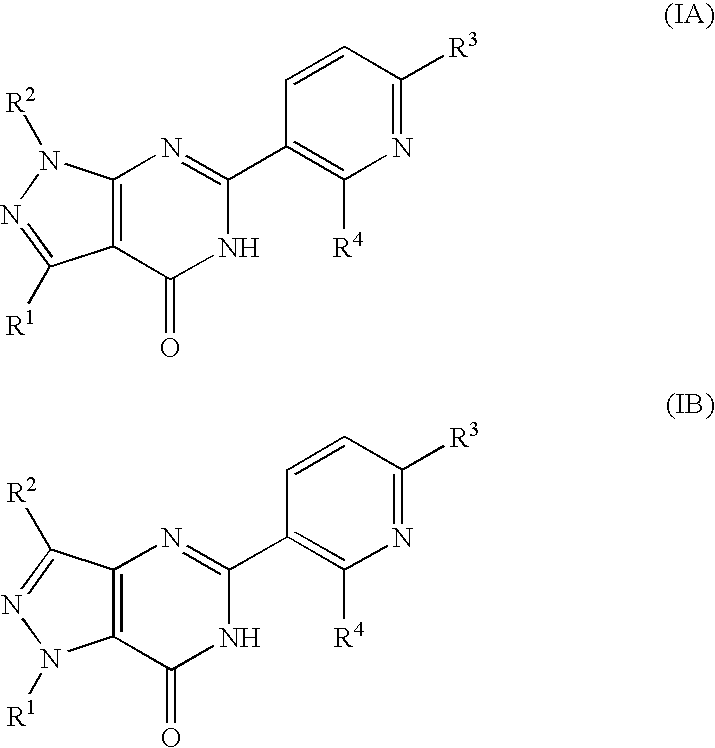Pyridinylpyrazolopyrimidinone derivatives as PDE 7 inhibitors
a technology of pyrazolopyrimidinone and derivatives, which is applied in the direction of antibacterial agents, immunological disorders, drug compositions, etc., can solve the problems that no curative medicines having pde 7 inhibiting effect as main pharmacological mechanism have developed up to now, and achieve significant pde 7 inhibiting effect, low toxicological properties of the compounds of the present invention, and high safety margin
- Summary
- Abstract
- Description
- Claims
- Application Information
AI Technical Summary
Problems solved by technology
Method used
Image
Examples
examples
[0111] The present invention is illustrated in more detail by way of the following Biological Test and Examples, but it is to be noted that the present invention is not limited by those Examples in any way.
[0112] The synthesis of the compounds of the present invention and intermediate compounds to be used in the synthesis are illustrated in the Example mentioned later. Further, the physicochemical data and chemical structure of the compounds and intermediate compounds obtained by the Examples are summarized in the Tables mentions later.
[0113] The compound numbers in the Examples are identical to those in the Tables.
[0114] The PDE 7 (phosphodiesterase VII) inhibiting effect of the compounds of the present invention obtained in the later mentioned Examples was evaluated by mean of the following Biological Tests.
example 1
2-Cyclohexyl-5-methyl-2,4-dihydro-3H-pyrazol-3-one
[0142] A mixture solution of 14.5 mL (0.134 mol) of methyl acetoacetate and 20.2 g (0.134 mol) of cyclohexylhydrazine hydrochloride was stirred for 2 hours at 120° C., and the mixture was cooled. Then, the reaction mixture was neutralized with 30 mL of 4M-sodium hydroxide solution and extracted with ethyl acetate. The organic layer was washed with water and saturated saline solution and dried over anhydrous sodium sulfate. The solvent was removed under reduced pressure, and the resulting residue was treated with hexane. The resulting precipitate was collected to give 19.0 g (79%) of the titled compound.
example 2
5-Chloro-1-cyclohexyl-3-methyl-4-nitro-1H-pyrazole
[0143] To 9.3 g (51.6 mmol) of the compound obtained by the Example 1 was added 10 mL (107 mmol) of phosphorus oxychloride, and the mixture was stirred for 10 hours at 120° C. The reaction mixture was cooled to the room temperature and excess phosphorus oxychloride was removed off under reduced pressure. The resulting residue was dissolved in 45 mL of acetic anhydride, and to this mixture was gradually added by dripping 9 mL of fuming nitric acid under ice cooling and the mixture was stirred for 2 hours at the same temperature. Then, the mixture was poured into ice and the resulting precipitate was collected and dissolved in dichloromethane. The organic layer was washed with sodium hydrogen carbonate aqueous solution, water and saturated saline solution, and dried over anhydrous sodium sulfate. The solvent was removed under reduced pressure, and the residue was recrystallized from hexane to give 6.28 g (50%) of the title compound. ...
PUM
| Property | Measurement | Unit |
|---|---|---|
| temperature | aaaaa | aaaaa |
| temperature | aaaaa | aaaaa |
| temperature | aaaaa | aaaaa |
Abstract
Description
Claims
Application Information
 Login to View More
Login to View More - R&D
- Intellectual Property
- Life Sciences
- Materials
- Tech Scout
- Unparalleled Data Quality
- Higher Quality Content
- 60% Fewer Hallucinations
Browse by: Latest US Patents, China's latest patents, Technical Efficacy Thesaurus, Application Domain, Technology Topic, Popular Technical Reports.
© 2025 PatSnap. All rights reserved.Legal|Privacy policy|Modern Slavery Act Transparency Statement|Sitemap|About US| Contact US: help@patsnap.com



